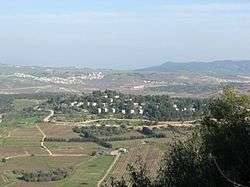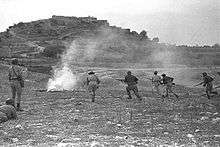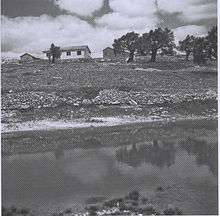Sasa, Israel
| Sasa | |
|---|---|
 | |
 Sasa | |
| Coordinates: 33°1′36.83″N 35°23′40.2″E / 33.0268972°N 35.394500°ECoordinates: 33°1′36.83″N 35°23′40.2″E / 33.0268972°N 35.394500°E | |
| District | Northern |
| Council | Upper Galilee |
| Affiliation | Kibbutz Movement |
| Founded | January 1949 |
| Founded by | Hashomer Hatzair members |
| Population (2015) | 398[1] |
| Website | www.sasa.org.il |
Sasa (Hebrew: סָאסָא) is a kibbutz in the Upper Galilee area of northern Israel. Located one mile from the border with Lebanon, it falls under the jurisdiction of Upper Galilee Regional Council. In 2015 it had a population of 398.
History
Antiquity
At the site of Sasa, remains of a settlement from the Bronze Age (early second millennium B.C.) have been unearthed, such as walls, tombs, cisterns, olive and wine presses. One house of the village of Sa'sa' had foundations which has been dated back to the fourth century by archaeologists.[2]
Middle Ages
The Arab geographer Abū 'Ubayd 'Abd Allāh al-Bakrī (d.1094) reported that one passed through Sa'sa' when travelling from Dayr al-Qasi to Safad.[2]
An excavation which took place in 2003 yielded ceramics dated to the fourteenth–fifteenth centuries CE.[3]
In 1516 Sa'sa', with the rest of Palestine, came under the control of the Ottoman Empire. Shortly after, Sa'sa' was made a checkpoint where a toll was collected on various goods and travellers; the first records of such taxes are from 1525/6.[4]
In 1596 Sa'sa' was classified as a village in the nahiya ("subdistrict") of Jira, part of liwa' ("district") of Safad, with a population of 457. It paid taxes on wheat, barley, olives and fruits, as well as on goats, beehives, and vineyards.[5] According to this daftar, there were no non-Muslim inhabitants in the village.[6]
In the eighteenth century Sa'sa' is mentioned as one of the fortified villages of Galilee controlled by Zahir al-Umar's son, Ali. After the defeat of Zahir al-Umar in 1775 Ali continued to resist the Ottoman authorities and defeated an army sent against him at Sa'sa'.[7] Excavations in 1972 on the west side of the hill revealed the remains of a large rectangular structure (15m x 41 m) with 2m thick walls made out of rubble stone with ashlar facing. At the south-west corner of the building there was a solid semi-circular tower (diameter 7m). The main part of the structure is a rectangular hall divided into two rows of five bays. There was a central row of four piers and two half-piers which would probably have supported a cross-vaulted roof. In a later phase an outer skin (2m wide) was added, making the wall a total of 4m thick. At the same time the round tower was converted into a square plan. According to the excavators, the place was occupied for a "fairly long" period, and suggest that it was probably part of the fortress built by Ali, son of Zahir al-Umar, in the eighteenth century.[8] The design of the building is quite compatible with other fortresses of the period, like Qal'at Jiddin and Dayr Hanna.[6]
In the late nineteenth century, Sa'sa' was described as a village with a population of 300, built on a slight hill that was surrounded by vineyards and olive and fig trees.[9]
All the villagers were Muslim. The village had a small market-place in the village center with a few shops, as well as a mosque and two elementary schools, one for girls and one for boys. In 1944/45 the village, with a population of 1,130, used 4,496 dunams for cereals; 1,404 dunams were irrigated or used for orchards.[2]
1948 war
In February 1948, Yigal Allon, commander of the Palmach in the north, ordered an attack on Sa'sa'. The order was given to Moshe Kelman, the deputy commander of the Third Battalion. The order read: "You have to blow up twenty houses and kill as many warriors as possible".[10][11] According to Pappé, the quote says "warriors" which he felt should be read "villagers". Pappe, however, does not attribute a source to the quote.[10] Khalidi, on the other hand, references "The History of the Haganah" by Ben-Zion Dinur, and reads the quote as "fighters."
One history of 1948 asserts that the reason for the attack was to restore Jewish public confidence in their fighting forces following the deaths of all the members of a platoon attempting to take supplies to Kfar Etzion a month previously.[12]
On 15 February 1948, a Palmach unit entered the village during the night and, without resistance, planted explosives against some of the houses. It was reported at the time that ten or more houses were totally or partially destroyed and 11 villagers were killed (5 of them small children).[13] According to the official history of the Haganah, the village had been used as a base for Arab fighters.[11] However, press reports at the time belie this, since the Palmach units met "without opposition" in the village.[11] According to Benvenisti (who gives the date of the attack as 14 February), the Palmach units that raided Sa'sa' killed 60 people and demolished 16 houses.[14]

It was not until 30 October 1948, as part of Operation Hiram, that the forces of the Haganah occupied Sa'sa'. Those villagers who had not already fled were expelled. There are also allegations of war crimes at this time. Northern Command OC Moshe Carmel later reported that he had seen evidence of killings, and an official investigation by Major Emanuel Yalan suggested that some villagers, including cripples, may have been killed after the village was occupied. However, the relevant files remain closed to historians.[15]
State of Israel: Kibbutz Sasa
The modern kibbutz was founded in January 1949 by a gar'in of North American Hashomer Hatzair members on the land of the depopulated Arab village of Sa'sa'.[16] Sa'sa' was demolished by the Israeli Seventh Brigade and Oded Brigade on October 30, 1948. Sa'sa' surrendered without resistance and allegations of Israeli atrocities later surfaced.[17] Many of the villagers from Sa'sa live in Nahr al-Bared, a Palestinian refugee camp in Lebanon,[18] although some resettled in nearby Jish.

On the grounds of the kibbutz is the alleged tomb of rabbi Levi ben Sisi, who is actually known to have died in far-away Babylonia during the first half of the third century.[19]
In 1992, the Palestinian historian Walid Khalidi described the remains of Sa'sa' village: "Some of the old olive trees remain, and a number of walls and houses still stand. Some of the houses are presently used by the kibbutz; one of them has an arched entrance and arched windows. A large portion of the surrounding land is forested, the rest is cultivated by Israeli farmers."[20] The village mosque has been converted into the kibbutz museum.
Economy
.jpg)
Sasa operates Plasan, a plastics factory that manufactures vehicle armour. The company, which is shared between some 100 families, is now a world leader in armor protection technology for vehicles. The kibbutz has signed contracts worth billions of dollars with major clients,[21]including the U.S. military.[22]
Other branches of the economy include a dairy, in cooperation with kibbutz Tuval; a beef herd; fruit trees (kiwi, apple, avocado and grapefruit); Bereshit, a fruit marketing company in cooperation with three other kibbutzim; and Sasa Tech, a manufacturer of technical and home care products.[23] Buza, a chain of ice cream shops founded by a Sasa resident, runs a branch on the kibbutz and offers ice cream workshops.[24]
References
- ↑ "List of localities, in Alphabetical order" (PDF). Israel Central Bureau of Statistics. Retrieved 16 October 2016.
- 1 2 3 Khalidi, 1992, p. 495
- ↑ Bron, 2006, Sasa
- ↑ Cohen and Lewis, 1998, p 57, 58
- ↑ Hütteroth and Abdulfattah, 1977, p. 176. Quoted in Khalidi, 1992, p. 495
- 1 2 Petersen, 2001, p.274
- ↑ Cohen, 1973, p. 93, 97. Cited in Petersen, 2001, p.274
- ↑ Gibson and Braun, 1972. Cited in Petersen, 2001, p. 274
- ↑ Conder and Kitchener, 1881, SWP I, p. 200. Quoted in Khalidi, 1992, p.495
- 1 2 Pappe, 2006, p 77
- 1 2 3 Khalidi, 1992, p. 496
- ↑ Kurzman, Don (1970) Genesis 1948. The First Arab-Israeli War. An Nal Book, New York. Library of Congress number 77-96925. p.53
- ↑ New York Times, Feb 16, 1948. Also cited in Khalidi, 1992, p. 496.
- ↑ Benvenisti, 2000, p. 107
- ↑ Morris, 2004, p. 481, 501, 503.
- ↑ Khalidi, Walid (1992). All That Remains: The Palestinian Villages Occupied and Depopulated by Israel in 1948, Washington D.C.: Institute for Palestine Studies. p. 495
- ↑ Operation Hiram
- ↑ Ilan Pappé, "The Ethnic Cleansing of Palestine", page 183
- ↑ Pictures of Tzaddikim's graves in Eretz Yisrael Yeshivat Tikun HaMidot
- ↑ Khalidi, 1992, p. 497
- ↑ Plasan Sasa wins contract
- ↑ Kibbutz Sasa's Plasan nets second big U.S. military tender
- ↑ Sasa website
- ↑ the Sea of Galilee for the Galilee by the sea